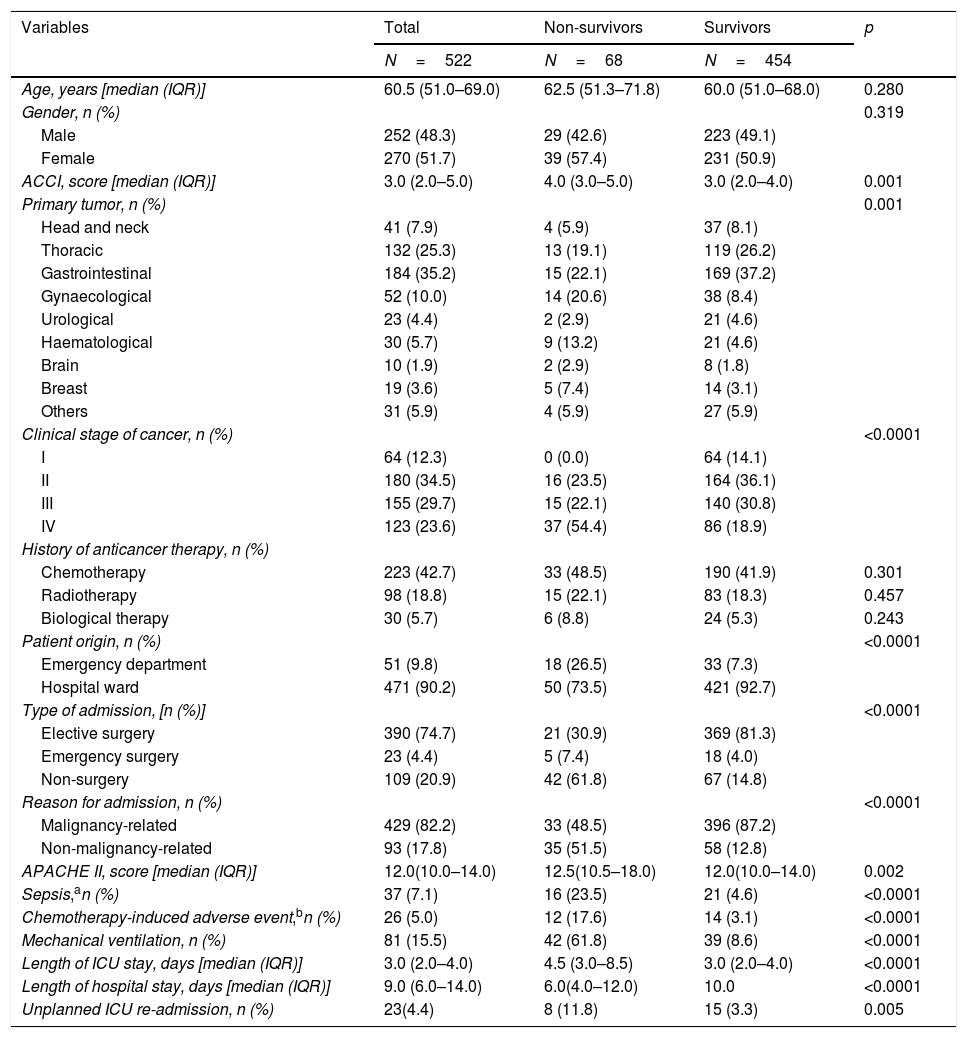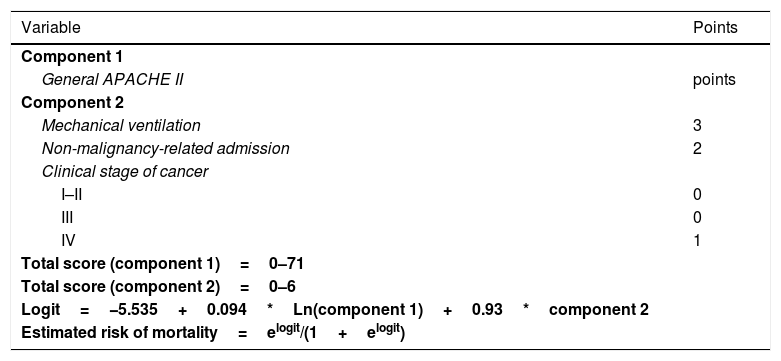To improve the accuracy of the Acute Physiology and Chronic Health Evaluation (APACHE) II model for predicting hospital mortality in critically ill cancer patients.
Materials and methodsThis was a prospective cohort study of 522 patients admitted to ICU with a solid tumor. We developed the “APACHE II score for critically ill patients with a solid tumor” (APACHE IICCP score), in which typical variables of critically ill cancer patients were added to general APACHE II score. Calibration and discrimination were evaluated by Hosmer–Lemeshow test (H–L) and area under receiver operating characteristic curve (AROC), respectively. The improvement in predicting hospital mortality with the new model was assessed using a reclassification analysis by integrated discrimination improvement (IDI), net reclassification improvement (NRI; cut-off point of 20% in risk of death) and quantitative NRI (qNRI).
ResultsThe hospital mortality rate was 13%. Discrimination was superior for APACHE IICCP score (AROC=0.91 [95% CI 0.87–0.94; p<0.0001]) compared to general APACHE II score (AROC=0.62 [95% CI 0.54–0.70; p=0.002]). Calibration was better using APACHE IICCP score (H–L; p=0.267 vs. p=0.001). In reclassification analysis, an improved mortality prediction was observed with APACHE IICCP score (IDI=0.2994 [p<0.0001]; total qNRI=134.3% [95% CI 108.8–159.8%; p<0.0001]; total NRI=41.5% [95% CI 23.7–59.3%; p<0.0001]).
ConclusionsThe performance of APACHE IICCP score was superior to that observed for general APACHE II score in predicting mortality in critically ill patients with a solid tumor. Other studies validating this new predictive model are required.
Mejorar el rendimiento de la escala Acute Physiology and Chronic Health Evaluation (APACHE) II para la predicción de muerte hospitalaria en pacientes críticos con cáncer.
Materiales y métodosEstudio prospectivo de 522 pacientes con cáncer sólido admitidos en UCI. Se creó la «escala APACHE II para pacientes con cáncer sólido» (escala APACHE IIPCC); se adicionaron variables típicas del paciente oncológico crítico a la escala APACHE II general. Se evaluó la calibración (prueba de Hosmer–Lemeshow [H–L]) y discriminación (área bajo la curva de las características operativas del receptor [ACOR]). Se utilizó la mejora en la discriminación integrada (IDI), mejora neta en la reclasificación (NRI; 20% como valour de corte en el riesgo de muerte) y NRI cuantitativo (cNRI) para evaluar la mejora en la predicción de muerte hospitalaria con el nuevo modelo.
ResultadosLa mortalidad hospitalaria fue del 13%. La discriminación fue superior con la escala APACHE IICCP (ACOR=0,91 [IC del 95% 0,87–0,94; p<0,0001]) comparado con la escala APACHE II general (ACOR=0,62 [IC del 95% 0,54–0,70; p=0,002]). La calibración fue mejor con la escala APACHE IICCP (H-L p=0,267 vs. p=0,001). En el análisis de reclasificación se observó una mejora en la predicción de muerte con la escala APACHE IICCP (IDI=0,2994 [p<0,0001]; cNRI=134,3% [IC del 95% 108,8–159,8%; p<0,0001]; NRI=41,5% [IC del 95% 23,7–59,3%; p<0,0001]).
ConclusionesLa escala APACHE IICCP fue superior a la escala APACHE II general en la predicción de muerte en pacientes críticos con cáncer sólido. Se requieren otros estudios que validen este nuevo modelo predictivo.











